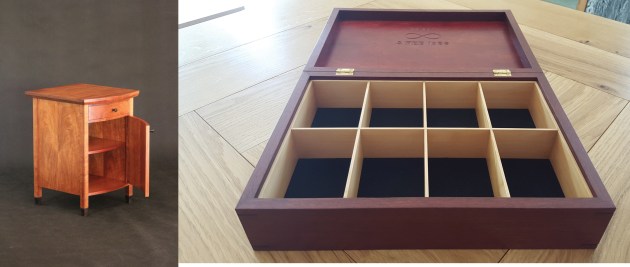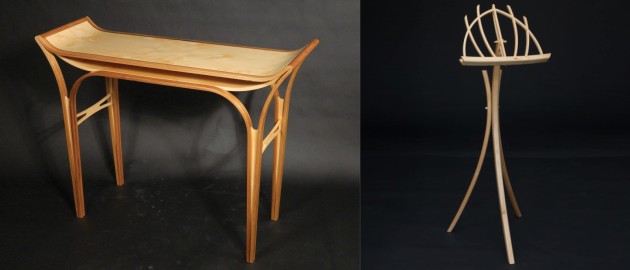AWR Studio Furniture 2018: Meet the Entrants 17
Finally, the October 20, 2018 unveiling of AWR Studio Furniture at Bungendore Wood Works Gallery, NSW is almost here. We now have an extraordinary collection of work to present. Shortlisted entrants in Australia, New Zealand and Denmark have put their hearts and souls into creating new work, and in so doing many have reached new levels as designers and makers.
The contemporary works to be displayed include tables, drinks cabinets, drawer chests, credenzas, chairs, rockers, boxes, mirrors, lighting and wall hung cabinets. None of the pieces have ever been shown before. This collection of fine handcrafted furniture is arguably the most significant that has even been offered to the buying public. The exhibition opens during Wood Dust Australia, and will run until January 31, 2019.
This concludes our series that featured all entrants to AWR Studio Furniture 2018.
At the opening of AWR Studio Furniture 2018 over $21,000 in awards will be presented:
Bungendore Wood Works Gallery is sponsoring a massive $15,000 in cash awards, including a first prize of $10,000.
Felder Award for Fine Woodworking, a Hammer N4400 bandsaw valued at $3166
George Ingham Chair Prize, $1000 sponsored by Adrian Potter
Interwood Award for Excellence, $1000 sponsored by InterwoodShop.com.au
Emerging Designer Maker, $1000 sponsored by Studio Woodworkers Australia
You can now begin to see images of the actual work created for the exhibition by shortlisted entrants on our Instagram (see #studiofurniture 2018) and Facebook pages.
We are grateful to our sponsors for their support: Bungendore Wood Works Gallery, Felder Group Australia and Branch 95 Timbers.

Takeshi Iue
Achieving simplicity is the goal for Japanese-born, Adelaide-based furniture designer Takeshi Iue. Simplicity in concept, form, materiality and ultimately construction, but perhaps not process, as Iue’s design development is often a lengthy series of exacting and painstaking iterations – a necessary progression to reach a final piece that meets his high standards. Like his design process, Iue is rigorous with his development as a practitioner. He holds three design qualifications: a Bachelor of Visual Communication from the University of South Australia, a Diploma of Art (Furniture Design) from the Douglas Mawson Institute of TAFE and a two-year Furniture Studio Design Associateship from Adelaide’s JamFactory. Website: http://www.takeshiiue.com

Ross Annels, Cooroora Institute
Ross is a studio furniture maker, wood artist and sculptor. Ross’s childhood was in mill towns amidst the tall eucalypt forests of Western Australia, and after studying in the biological sciences, philosophy and in design, and working in academic and corporate roles, he has spent the last twenty years practising his craft, regenerating rainforest and caring for country and kin in subtropical Queensland, Australia. He co-directs the Cooroora Institute: sharing the song of the earth through creative practice, and bringing together artists, musicians and intellectuals interested in the artistry of place. His work investigates the partnerships that become possible in the making with natural materials and ways to express the many more-than-human creative practices in the world. Birdsong becomes furniture, wood grain becomes block prints, leaves become copper sculptures; the politics of humanity rewoven into the ecology of the earth. Ross says, "I hope by building collaborative practice with other artists and with the places we inhabit we might all be inspired to step more joyfully and lightly upon this world, to which all life is inextricably and indivisibly bound." Ross makes work for exhibition, for public spaces and for Australian and international clients, combining traditional making techniques with innovative contemporary designs. Ross has exhibited in Australia, New Zealand, Germany and Canada, and his work is in homes and private collections around the world. Website: https://www.cooroorainstitute.org/

Alexsandra Pontonio
A love of the bush, a commitment to sustainability and the pleasure of working with her hands have been a constant in Alexsandra Pontonio’s career. Initially studying social sciences at RMIT University, focusing on sustainability and environmental policy, she spent her spare time bush walking in Victoria’s High Country. A two-year program studying furniture design, also at RMIT University, allowed Pontonio to work with her hands, as well as explore her sustainable approach. “I’m not interested in consumerism or predicting the latest trends. I’m interested in producing furniture that has longevity, pieces that can be passed on through the generations. After graduating with an Associate Degree in Design (Furniture) from RMIT University in 2015, Pontonio has been involved in a ‘wave’ of projects, some local, others further afield, such as the Milan Furniture Fair (2016). Included as part of the ‘Melbourne Movement’, founded by eminent designer and teacher Kjell Grant.

Bernard Chandley, Bernard Chandley, Chairmaker and Fine Furniture
Bern Chandley handcrafts Windsor chairs using both traditional and modern techniques, devoting himself to the task of creating pieces of heirloom quality. Windsor chairs have incredibly strong joinery allowing them to endure generations of punishment. There are numerous original chairs up to nearly 300 years old extant. All windsor chairs have solid hand carved seats into which all parts are round tenoned. The leg tenons are tapered at 6 degrees matched by the mortices which are drilled through the seat then reamed at 6 degrees. When glued in place a wedge is driven into the top of the leg creating an immensely strong and durable joint. The structure of these chairs allows for an almost endless variety of designs. From decorative traditional to simplified modern and anything in between. The chairs are finished in water based paint, natural oils and wax. His work also includes all manner of tables and cabinets with an emphasis on hand finished details thus ensuring unique characteristics to each and every piece of furniture. Website: http://www.bernchandleyfurniture.com

Julian Glencross McCartney, Glencross Furniture
Glencross Furniture was founded by Julian Glencross McCartney in 2012, inspired by his family history and intensive training in traditional cabinet making. Julian operates independently from his Melbourne-based workshop, specialising in high quality custom made timber furniture and design objects. His design styles are varied, with an awareness of the ever-changing functional and aesthetic requirements of our living environments. Key to his work is a keen eye for proportion and detail, and a carefully considered understanding of timbers and complementary materials. The result is a handcrafted, tactile finish to be celebrated and enjoyed every day. Website: www.glencross.com.au

Douglas Keith
My name is Douglas Keith and I'm a young 23 year old fine furniture maker based in Canberra. I work for Myles Gostelow who also trained and mentored me during my apprenticeship. We specialise in one off custom pieces of handcrafted fine furniture. The ability to create something unique and of very high quality from nothing less than a few hand selected boards drives my passion for the craft. Throughout my apprenticeship I was awarded with the following: 2015 FIAA Regional Apprentice of The Year, 2015 National John Tiddy Apprentice Of The Year, 2017 FIAA Apprentice Of The Year, 2017 Most Outstanding Achievement Award Of The Year and 3rd in the National Worldskills Cabinet Making Competition. Under Myles’s close mentoring and leadership, I will continue to develop and hone my skills to hopefully owning and running a successful fine furniture business.

Ray Brien
I am a self employed bespoke designer and maker, living and working in a Launceston. I manufacture furniture and small items in Tasmanian timbers on commission and for gallery sales. I completed an associate degree in Furniture Design at UTAS school of fine furniture in 2010 and was entered in the Dean's role for excellence in 2008. My works are based on my interest in late Ming, early Qing dynasty Chinese furniture, Japanese joinery techniques and Art Deco designs.

Niklavs Rubenis
Niklavs Rubenis is a designer and maker with a diverse studio and research practice. He has been involved with design projects spanning community, non-profit, residential, commercial and cultural institutions, and has had work exhibited and presented nationally and internationally. Rubenis is also involved in a range of national curatorial and collaborative projects, regularly writes for publications, and has been the recipient of industry funding, grants and awards. Rubenis also serves as a Councillor on the Design Institute of Australia’s ACT executive committee and is an Accredited Professional Member of Craft ACT: Craft and Design Centre. Currently he divides time between studio practice, lecturing at the School of Art & Design, Australian National University, and teaching into the cabinet-making apprenticeship program at the Canberra Institute of Technology.

Vincent Conboy, Cenzo Design
I grew up tinkering with my father who studied furniture design in Tasmania. We were always working on random projects together from the early days whether or not at the time I saw them as projects or chores. That was the start of an early obsession with furniture design. As long as I can remember I’ve been designing. There are now many sketchbooks filled with good, bad and ugly pieces but each has a place and learning curve. I'm now in the second year of working for myself and constantly working towards learning new techniques and soaking up as much knowledge as I can whilst putting the theories into play. I love what I get to do every day, it’s life! I’m extremely appreciative that my eldest daughter is showing extreme interest in the weaving side of things. I can’t wait to see what she comes up with. Website: http://cenzo.net.au/

Elliott Bastianon
Elliot Bastianon is a furniture designer and maker based in Canberra, Australia. Graduating in 2012 from the Australian National University with a BA/BVA (Honours), he has a diverse material palette and attempts to extrapolate the most from everyday things around him; often combining materials in ways that he hopes will direct his practice down a path not often taken. His work is often characterised by hard edged geometry and a strong use of repetition, drawing inspiration from visual arts and architecture as well as traditional craft methods. For Bastianon, furniture isn’t just something utilitarian. It’s an apparatus of communication, a tool to deliver a message or encourage a different way of seeing the world. Website: www.elliotbastianon.com



